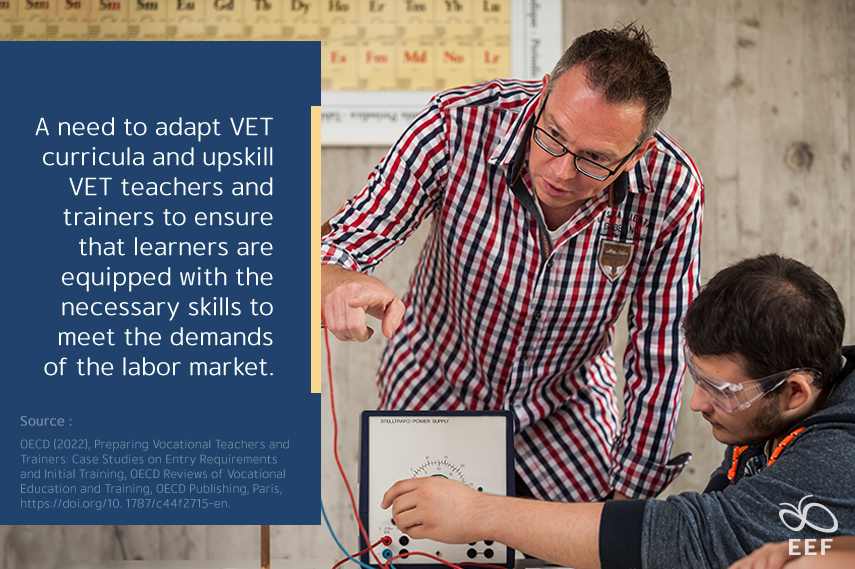
Vocational Education and Training (VET) teachers and in-company trainers hold the keys to unlocking the potential and shaping the future of learners from different walks of life. They are the backbone of the educational system when it comes to school-to-work transitions: guiding and supporting learners in both classroom-based and work-based learning environments and helping them to make a smooth transition from education to employment. The real question is though, how can we ensure that these teachers and trainers are well-equipped to handle this critical responsibility?
According to the “OECD Reviews of Vocational Education and Training Preparing Vocational Teachers and Trainers: Case Studies on Entry Requirements and Initial Training,” there are two ways to go about it. The first approach involves setting some kinds of strict entry requirements for the VET teaching and training profession to ensure quality and consistency. Many countries require that teachers have, among many things, specific teaching qualifications, vocational qualifications, and work experiences. Likewise, some countries impose regulations on the organization and delivery of in-company training, including in some cases requirements for trainers. Nonetheless, not all countries introduce specific standards for the pedagogical qualifications or skills of trainers.

The second approach entails providing initial education and training to VET teachers and trainers. Initial Teacher Education and Training (ITET) equips prospective and new teachers with the necessary skills and qualifications to succeed. It is implemented differently across the globe, but typically takes the form of a teacher-training degree course at the tertiary education level, supplemented with practical training. In many countries, prospective and new VET teachers are offered targeted financial support to help them benefit from ITET. Similarly, in some countries, in-company trainers can benefit from preparatory and continuous training programs, which are more often than not optional.
While stringent entry requirements and initial education and training contribute to the quality of the teaching and training workforce, stringent qualifications and lengthy preparation times can deter potential VET teachers and trainers from entering the professions, creating roadblocks to the provision of work-based learning. This could contribute to the shortages of VET teachers and trainers faced by many countries, although there are many reasons for such shortages. Thus, it is paramount to offer flexible ways to recruit and qualify VET teaching and training personnel, while still ensuring they have the necessary skills and knowledge to not only be up to the tasks but also excel in their roles.
Striking a perfect balance between flexible entry requirements and comprehensive training programs is thus crucial in cultivating a well-equipped and dynamic VET teaching and training workforce. Countries like Canada, Denmark, Germany, the Netherlands, and Norway, have shown that achieving this balance is possible through the implementation of entry requirements and training programs, without compromising on flexibility, through a combination of vocational and pedagogical qualifications, relevant work experience, and alternative pathways for individuals coming from industry. These countries offer valuable insights into how they have managed to develop a skilled teaching and training workforce that can respond to the ever-changing demands of the job market.
For VET teachers, all 5 countries require a vocational and pedagogical qualification, with some of them also requiring work experience. There are multiple routes to enter the profession, which are designed to overcome possible barriers and ensure that prospective teachers meet the necessary professional and pedagogical standards. In Germany and the Netherlands, where requirements are relatively strict, more flexible alternative pathways are available to individuals from the industry. On the other hand, in-company trainers are usually expected to have a vocational qualification and experience in all five countries, with only Germany requiring that companies have at least one trainer who passes a trainer aptitude examination that testifies to their professional and pedagogical skills. However, some sectors, regions, or companies in other countries may impose similar requirements.

Initial training and preparation for VET teachers vary among the five countries, with different lengths and contents of Initial Teacher Education and Training (ITET) programs and providers. In Germany, teacher training at universities includes a bachelor’s and a master’s program, followed by a preparatory service as a teaching practicum. In Denmark, the VET-pedagogy diploma program is offered by universities and colleges as part of the higher adult education system. On the other hand, initial training and preparation for in-company trainers are optional rather than mandatory in all 5 countries, and training programs are primarily non-formal and typically offered by various providers. In Canada, these programs are provided by different provincial and territorial apprenticeship authorities, employers, industry associations, and universities.
The success stories shared in the case studies also highlight the critical importance of finding the right balance between quality and flexibility when it comes to attracting and training VET teachers and trainers. It is a delicate matter that requires a nuanced approach. The different countries have varying degrees of flexibility and take different approaches to achieve this, but there are valuable insights to be gained from these examples.

Entry requirements must be transparent and clear without sacrificing flexibility to ensure that prospective VET teachers with relevant skills and knowledge can enter the profession, even if they do not meet all the requirements, and that new VET teachers possess the necessary skills and knowledge. Meanwhile, providing high-quality ITET opportunities that are easily accessible with targeted financial support is critical to ensuring prospective and new VET teachers develop the skills necessary for their profession. This way, prospective or new teachers can be confident in their abilities to provide quality training to their learners.
The autonomy given to providers of ITET for VET teachers over how they organize and deliver training can ensure that training meets the needs of the learners. However, to maintain quality, this must be coupled with solid quality assurance mechanisms. Coordination between VET institutions and teacher-training institutions is vital to designing and delivering VET teacher training. Partnering with VET institutions for subject-specific skills development and providing opportunities for aspiring VET teachers to practice in a VET institution can also enhance the quality of training provided.
In-company trainers should also have pedagogical skills to support their learners’ learning journey. Making flexible pedagogical training and materials available can help achieve this. Incentives must be provided to encourage trainers and their employers to take up training and cover all aspects of work-based learning, from start to completion. Regulations on the quality of work-based learning can foster the quality of trainers by taking a more holistic approach, allowing for more flexibility than strict qualification or skill requirements imposed on in-company trainers. By fostering quality trainers, learners can receive the training they need to meet the ever-increasing demands of the workforce.

As industries evolve and technological advancements are made, the skills and qualifications required in the workforce change. This calls for a need to adapt VET curricula and upskill VET teachers and trainers to ensure that learners are equipped with the necessary skills to meet the demands of the labor market. VET personnel plays a crucial role in bridging the gap between education and employment for learners from diverse backgrounds, and they must possess up-to-date theoretical and practical knowledge, as well as pedagogical skills to facilitate effective learning. Therefore, implementing strategies, such as flexible entry requirements, providing appropriate ITET programs, regulating in-company training, and targeted financial support, will go a long way in ensuring that VET teachers and trainers are adequately prepared to equip learners with the necessary skills for the workforce.
By learning from the different countries’ experiences, we can gain a better understanding of how to maintain this delicate balance, ensure high-quality training for VET teachers and trainers, and keep the workforce dynamic and responsive to the needs of learners and industries alike. After all, the success of vocational education and training relies on the teachers and trainers who make it happen, and they deserve our unwavering support to deliver the best outcomes for learners and society as a whole. This is in line with the mission of the Equitable Education Fund (EEF) Thailand, which is to help increase learning access, and learning outcomes to create system change and can lead toward the policy advocacy of equitable education for all.
Source:
OECD (2022), Preparing Vocational Teachers and Trainers: Case Studies on Entry Requirements and Initial Training, OECD Reviews of Vocational Education and Training, OECD Publishing, Paris, https://doi.org/10. 1787/c44f2715-en.
https://read.oecd-ilibrary.org/education/preparing-vocational-teachers-and-trainers_c44f2715-en

